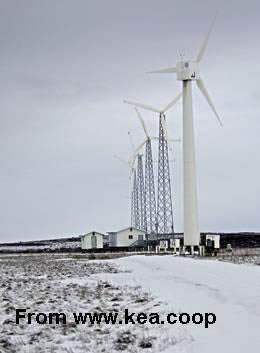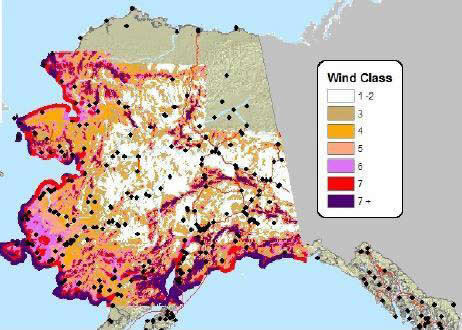Reinventing the WindmillOctober 30th, 2006Courtesy of Insurgent 49 
Alaska has a large amount of wind energy potential, especially for remote communities on the Aleutians and the western Alaska coast. The strongest winds in Alaska often happen during winter, corresponding to the time of peak energy demand. Home-sized small wind systems are available, and wind turbines can be scaled for use in small communities. Significant wind resources also exist close to several Alaska population centers, such as on Fire Island just west of Anchorage. Wind energy is the fastest growing renewable energy source in the world and, along with biomass, is the only non-hydro renewable energy source presently producing utility-scale power in Alaska. Wind turbines capture the kinetic energy of the wind with spinning rotors, similar to those of propeller or airplane wing, which convert it to rotational mechanical energy and turn generators to produce electricity. All electric-generating wind turbines, no matter what size, are comprised of the basic components: the rotor blades, the electrical generator, a speed control system, and a tower. Wind speed is the most critical feature of wind resources, as a stronger wind means a lot more power. For successful power generation, the winds must also be steady, since sudden gusts of chaotic winds can damage equipment and make the supplied electricity unreliable. In the United States, millions of windmills were erected as the American West was developed during the late 19th century, most of which were used to pump water for farms and ranches. By 1900, small electric wind systems were developed to generate direct current. By 1910, wind turbine generators were producing electricity in many European countries and the United States. However, most of these early wind generator units fell into disuse as the power grid was extended to rural areas during the 1930s. Strong winds are found across the USA, particularly in the western states and the Great Plains. The US Department of Energy (DOE) estimates that the total wind power potential is at least 50% more than the nation's present total of 775,000 megawatts (MW) of total installed electric generation capacity. In theory, just the two states of North and South Dakota have enough wind energy potential to power the entire USA. About 0.25% of the electricity in the U.S. now comes from wind power, though that amount is growing fast. At the end of 2005, the total wind generation capacity in the USA was around 9,150 MW, with 3000 MW more slated to come online by the end of 2006, worth several billion dollars in generation equipment. The U.S. wind industry projects 100,000 MW of wind capacity installed nationwide by the year 2020. The ten U.S. states with the most wind power capacity installed at the end of 2005 were California (2150 MW), Texas (1995 MW), Iowa (836 MW), Minnesota (744 MW), Oklahoma (475 MW), New Mexico (407 MW), Washington (390 MW), Oregon (338 MW), and Wyoming (288 MW). The nation's largest wind power generating firm is FPL Energy, with 3600 MW of wind generation capacity. European electric utilities are investing heavily in U.S. wind farms. For example, PPM Energy, a subsidiary of Scottish Power of the UK, controls 574 MW of installed U.S. wind power capacity. ENEL North America, which is a spin-off of what was formerly Italy's state-owned electric monopoly ENEL, is still 31.1% owned by the Italian government. ENEL North America is in the process of developing 1000 MW in the USA alone, putting the government of Italy as a greater direct investor in U.S. wind energy than the government of the U.S. itself. However, the U.S. DOE's Wind Energy Program is actively testing new wind turbine technology at the National Wind Technology Center (www.nrel.gov/wind/) in Colorado, and at Sandia National Labs (www.sandia.gov/wind/) in New Mexico. Low wind speed technologies are under investigation by the DOE, since areas with low wind speeds are 20 times more common than sites with high wind speeds. The largest wind turbine manufacturer based in the U.S. is General Electric's wind energy division. Overall, the worldwide generating capacity of wind energy has grown by more than 25% a year. The year 2005 set a record, with 11,500 MW of new wind generation capacity installed worldwide, pushing the total capacity to about 60,000 MW, three quarters of which is in Europe. Germany has more than 18,000 MW of wind generation capacity presently installed, the most of any country, followed by Spain (10,000 MW), Denmark (3000 MW) and the UK, the Netherlands, Italy and Portugal, each have more than 1000 MW. The Danish company Vestas is the world's largest wind turbine manufacturer, employing 10,000 people worldwide, and Denmark now generates over 20% of its power from the wind. 
Wind energy is also growing rapidly in Asia, with India already having over 5000 MW of installed capacity. China, with 1300 MW of installed wind power, plans to increase this amount to at least 30,000 MW of wind power by the year 2020, or enough power for 30 million average Chinese households. Wind energy is even catching on in the hydrocarbon-rich Middle East and North Africa. A 60 MW wind farm is being built near the Suez Canal in Egypt, and utility-scale wind power is growing in Morocco, Turkey, and Iran. There is a very high potential of wind energy beyond the world's coastlines, because wind speeds are usually higher offshore. Installing offshore wind turbines is more expensive that doing so on land, but costs are coming down as bigger turbines allow better economies of scale. Larger wind turbines, in the range of 4 to 5 MW, are being developed specifically for offshore use. The first offshore wind farm was built in Sweden in 1990, and about 20 offshore wind farms have been constructed, mostly in northern Europe. The European Wind Energy Association expects 10,000 MW of offshore wind energy capacity to be installed in Europe by 2010, and 70,000 MW by 2020. By the year 2015, Germany alone expects to install 10,000 MW of offshore wind. In the U.S., offshore wind farms are planned for the Nantucket Sound off Massachusetts, and off Long Island, New York. Challenges and EconomicsAlthough mechanical windmills have been around for centuries, getting the wind to produce reliable electricity has proved to be a mechanical engineering challenge that is still being resolved. The main disadvantage of wind power is that it is an intermittent energy source, and it is difficult to predict wind intensity on a minute-to-minute basis. Also, the strongest winds don't always blow when power is most needed. Some critics of wind energy claim that this variability makes wind an impractical energy source, but variations in demand are part of the everyday operations of any power grid. This variability as a "prime mover" has not prevented wind energy from powering over 60% of the electric grid of western Denmark and up to 50% in parts of Spain. A well managed power grid can take these high levels of wind 'penetration' with high reliability if it is 'firmed up' with more easily controlled energy sources such as hydroelectric, geothermal, natural gas, or even geothermal and biomass. Also, newer designs of large wind turbines with variable speed operations tend absorb temporary gusts better than earlier designs. Today, large-scale wind power is mostly used as a supplemental energy source, with more controllable power sources used as backup. However, the fact that wind power on a grid system is 'supplemental' does not mean that it has no value. Along Alaska's Railbelt power grid, which stretches from Homer to Fairbanks, natural gas and hydropower are the two largest sources of generation. Therefore, wind turbines would be contributing power to such a grid, even if intermittently, means that a certain amount of natural gas does not have to be burned, or water in a hydroelectric reservoir can be saved for a period of low wind. Wind turbines cannot readily be 'dispatched', that is, utilities cannot turn the wind on and off when needed. Because of this, wind power is generally considered an energy resource and not a capacity resource. For electric power generation, the capacity factor of a power plant is defined as the amount of actual energy delivered by the plant over a period of time, given as a percentage of the 'ideal' case of the plant continuously producing at its maximum output during the same period of time. The capacity factor of a wind farm is only up to 40%, usually around 30% to 35% for a good wind site. Wind energy cannot be stored, unless batteries are used for smaller systems. The Utility Wind Integration Group (UWIG) is an engineering group formed by a consortium of U.S. electric utilities, whose mission is "to accelerate the appropriate integration of wind power into utility systems" (www.uwig.org). The North American Electric Reliability Council (NERC), the body overseeing the power grid reliability of the U.S., Canada, and parts of Mexico, has created a wind energy task force which includes a UWIG representative. Both NERC and UWIG are working closely with the U.S. DOE, trade associations, and other industry research organizations on technical standards for large-scale wind generation. For all of its variability problems, wind energy is one of the most economical forms of utility-scale renewable energy available, with a "bus bar" price (which does not include transmission and distribution costs) of 3 to 6 cents per kWh at good wind sites. Efficiency of utility-scale wind power generation has improved greatly over the past two decades, with ever-larger turbines providing better economies of scale. Contemporary utility-grade turbines usually have a generation capacity between 1.5 MW and 2 MW, with an average rotor diameter of 80 m. It is becoming common practice for farmers in windy areas to lease their land for wind turbines for source of extra income. Thus wind energy has a huge untapped potential for sustainable rural economic development . The federal production tax credit of 1.9 cents per kWh of produced wind-electricity was renewed Congress in the Energy Policy Act of 2005, though is set to expire in 2007. Many U.S. wind projects depend on this subsidy to be profitable. 
Examples of Wind Energy In AlaskaThe Kotzebue Electric Association (KEA), the first Alaska utility to use wind power, has installed 14 small wind turbines since 1997, with a total present capacity of 660 kilowatts (kW). Wind now provides between 5 to 7% of Kotzebue's electric power needs, saving the city about 90,000 gallons of diesel fuel each year. KEA plans to expand its total wind capacity to an eventual 2 to 4 MW. On St. Paul Island in the Bering Sea, the TDX Power Corporation has installed a 225 kW wind generator system made by Northern Power Systems of Vermont. The Alaska Village Electric Cooperative (AVEC) has installed wind generators in both Selawik and Wales on the Bering Sea coast of far western Alaska. There are potentially 70 to 90 rural communities in Alaska that could reduce their energy costs by using wind energy. For example, 27 of AVEC's 52 villages are in wind regimes of 'class 4 or better' In 2004, AVEC purchased almost five million gallons of diesel fuel, only one of its 52 villages, Minto, can be supplied by fuel truck.  Map of Alaska Wind StrengthThe high price of diesel fuel has led to serious financial problems for several AVEC-served communities. Given a diesel efficiency of 14 kWh/gallon generated by the latest diesel 'gen-sets', this means that one 100-kW wind turbine might displace about 17,800 gallons of diesel fuel per year. AVEC has experimented with pilot wind-diesel power systems have been installed by AVEC in Selawik and Wales. Wind-diesel systems are underway or are being planned for Sand Point, Nikolski, Kasigluk, Hooper Bay, Chevak, Gambell, and Savoonga. In Toksook Bay, three 100 kW turbines have been installed, which will also help power nearby Nightmute and Tununak. The Alaska Energy Authority (www.akenergyauthority.org) has a wind met tower (anemometer) loan program, which is funded by the U.S. DOE and the Denali Commission. The program loans met towers, data logging equipment and technical support to Alaska communities and utilities interested in wind power, and so far has analyzed wind data from over 25 locations around the state. In remote communities, access for specialty equipment required to place foundations and erect wind turbines is a challenge. Foundations in permafrost are especially a challenge, and special piles for permafrost increase the cost of the wind turbine installation, as do transportation and logistical costs common to rural Alaska. Small scale wind turbines are made by only a handful of manufacturers as the industry gears itself for ever-larger turbines, and training of local technicians is necessary to keep the turbines operating. In the Fairbanks area, Golden Valley Electric Association (GVEA) has studied the wind potential of the Murphy Dome area, located about 20 miles northwest of Fairbanks. The Murphy Dome site was judged to have a wind energy potential of up to 100 MW, and is undergoing further study. GVEA installed a third met tower near Eva Creek north of Healy in July 2004, and is requesting additional funding to install met towers in several other potential sites in Alaska's interior near Delta Junction along the Richardson Highway. Kodiak Electric Association is investigating Pillar Mountain, just west of the city of Kodiak, as a potential wind energy site. Wind measurements conducted on the mountain so far look very promising. The Fire Island Proposal Fire Island lies about three miles west of the Anchorage airport, and consists of about 4,000 uninhabited acres. The Fire Island wind energy proposals, studied for the past several years by Chugach Electric Association (CEA) and other regional utilities, could produce up to 120 megawatts of power for the entire Railbelt. At present, the overwhelming majority of the Railbelt's electricity comes from Cook Inlet natural gas, which is getting steadily more scarce and expensive. For example, in 2005 88% of CEA's electricity came from natural gas and the other 12% came from hydropower. 
Model of Fire Island PlanIt is estimated that an 80 MW wind project on Fire Island would provide about 3 to 4% of the Railbelt's average annual electrical energy, though up to 10% of the Railbelt's peak winter load. CEA is working with Anchorage Municipal Light and Power, the Golden Valley Electric Association, Homer Electric Association, and the Native corporation Cook Inlet Region, Inc. (CIRI), which owns the lands on Fire Island on which the wind farm would be built. Concerns have been raised over a wind project's impacts on radar, due to the island's proximity to the Anchorage airport. A recent Dept. of Defense report on the radar effects of wind turbines concluded that there was no significant effect on military radar systems from wind turbines, and defers to the FAA and National Weather Service on issues of air traffic control and weather radars, respectively. The FAA has told CEA that the Fire Island wind project is by no means prohibited, just that some potential issues need to be worked out. The busy Kastrup Airport near Copenhagen, Denmark is located close to a number of onshore and offshore wind turbines which have not affected aviation. If Fire Island proves unworkable as a wind energy site, the utilities involved will (together or individually) begin studying other possible wind energy sites along the Railbelt. Wind Power and the EnvironmentBird deaths were a problem with many wind turbines installed before the 1990s, particularly in California, though newer wind turbines are larger with blades that turn slower, making it easier for birds to avoid impact. Bird habitat and avian interaction studies are still essential to minimize impacts on birds for each proposed wind project. Wind project developers need to consider prey populations, bird populations, and migratory routes as well as project size, turbine sizes, and site topography. Extracting too much kinetic energy out of wind within a small geographical area can disrupt natural wind patterns. In some cases, local micro-climates can even be altered to be the presence of turbines in key wind flows. Extensive wind surveys need to be conducted, not only find the best wind sites but also study possible environmental impacts. Some people consider large wind turbines to have negative visual impacts on the landscape. For all of the concerns described above, wind power remains the world's fastest-growing source of electricity. The most obvious environmental benefits of wind energy are that no fossil fuels are burned, so there is no air pollution. The economic benefit of renewable energy sources such as wind is that there are no fuel costs, and therefore no imported fuel is used. Alaskans should only expect more wind power in the years to come.
Wind energy links: Brian Yanity is a graduate student at UAA, activist and freelance writer. He resides in an undisclosed location in Southcentral Alaska, and can be reached at byanity@insurgent49.com. |
 
|